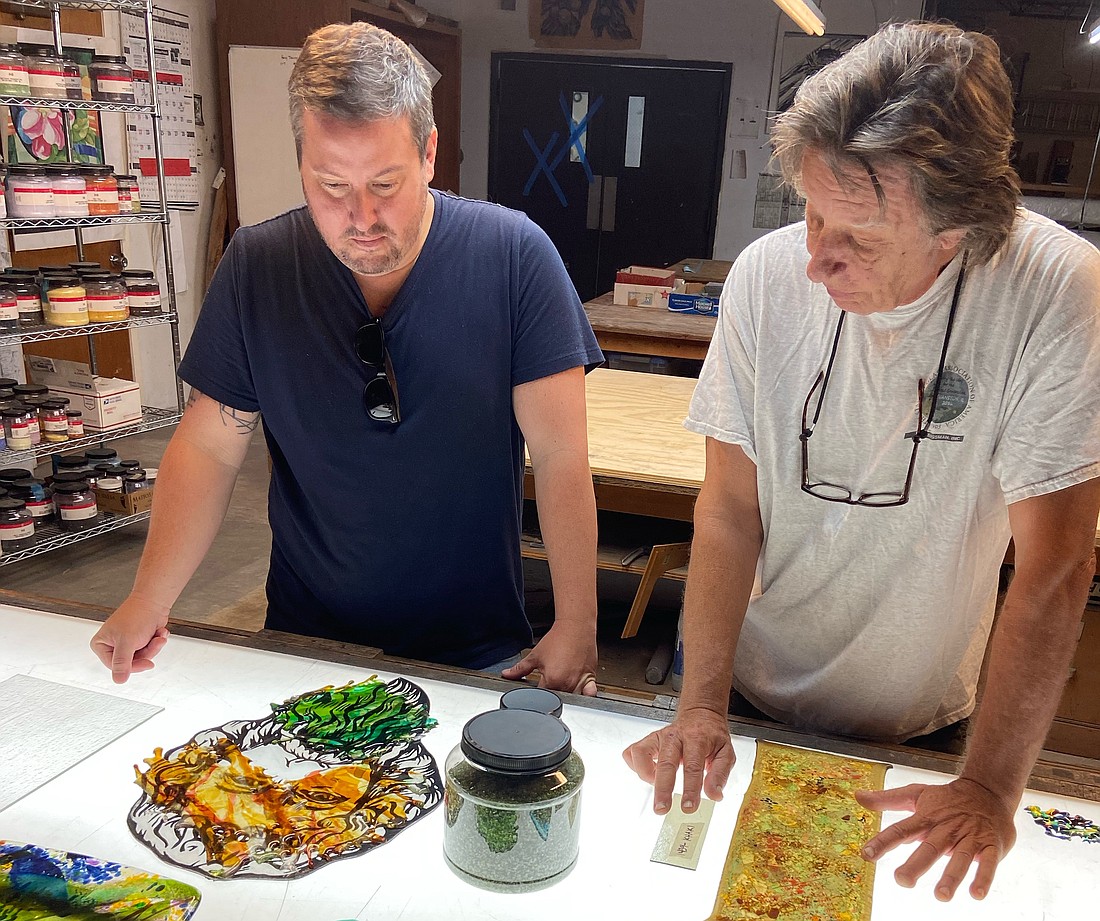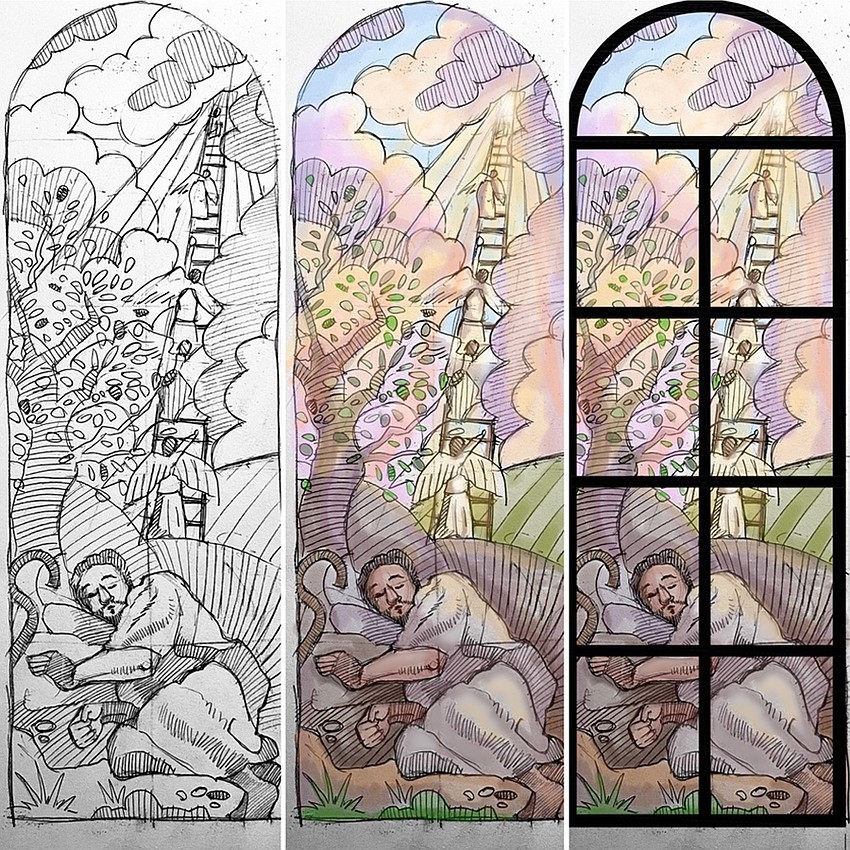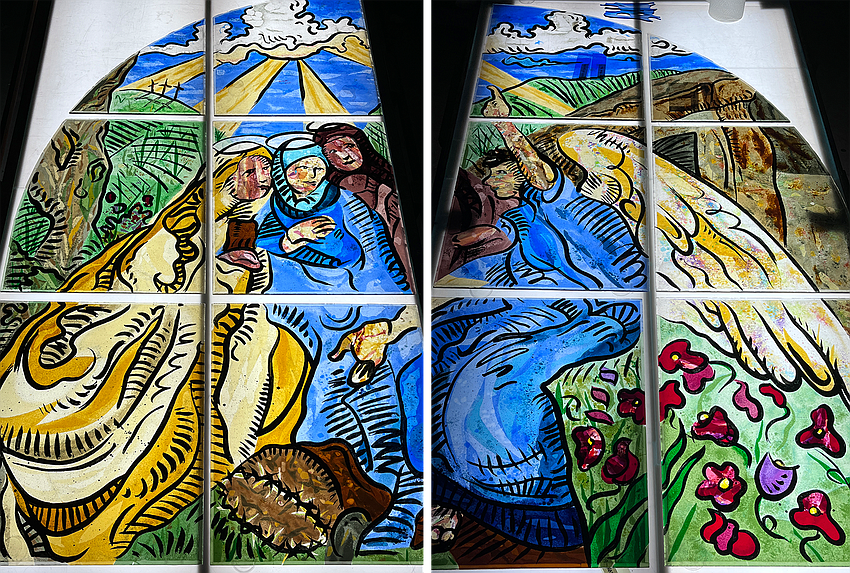- December 26, 2024
-
-
Loading

Loading

Tim Jaeger is the chief curator of galleries and exhibitions at Ringling College of Art and Design. He’s also an accomplished artist in his own right. As a painter he’s, well, painterly. His approach is gestural, with lots of multilayered impasto and loose, energetic brushwork. Coloring inside the lines is not Jaeger’s style. But a recent passion project took him out of his comfort zone.
Late in 2021, Jaeger accepted a commission to design and create 41 windows for a chapel in Tampa's Berkeley Preparatory School. His art would comprise Biblical vignettes and nods to other faiths. It would speak to the hearts of students. It would also have a deep, personal meaning to the artist.
“Berkeley Prep is affiliated with the Episcopal Church,” Jaeger says. “I’m the son of an Episcopal priest. Receiving this commission was very humbling for me.”
As a child, Jaeger grew up listening to his father’s sermons in the Grace Episcopal Church in Paducah, Kentucky. A well-behaved kid, he sat without fidgeting in a church pew. He listened intently, while simultaneously drawing on church bulletins. His father’s lessons took hold in his heart. But the training of his hand and eye would ultimately lead to his life’s work as an artist.
“I always knew I wanted to be an artist,” Jaeger says. “Following in my father’s footsteps just wasn’t my path. This commission is a magical way to honor his path. It’s not my usual medium — and I really wanted to do it right!”
The artist received the commission thanks to a drawing of St. Francis ministering to a flock of birds by the river. He showed it to Brandon Peete, the school chaplain. Jaeger explained that it would be one of many gentle religious scenes, including the baptism of Jesus and Jacob’s dream of a ladder to heaven.
“I explained that the vignettes would be religious,” Jaeger recalls. “But I also wanted to give the students a sense of freedom and creative expression, whatever their belief system.”
Chaplain Peete evidently liked the way the artist thought. Jaeger got the commission. Gentle scenes or not, it was an incredibly ambitious project — on a scale the artist had never before attempted.
To create the images he’d envisioned, Jaeger reached out to the master glass artists of our region. Jim Piercey was his first choice.
“Jim had the only studio space around equipped to do this project,” he says. “Jim taught me a lot of the technique, and installed everything we created. This will be the first chapel in the United States with fused glass windows.”
What’s the difference between fused glass and stained glass?
According to Jaeger, it’s a big difference. “Stained glass art is like making a mosaic,” he says. “You create the image with different pieces of colored glass. You assemble the pieces, and then solder them together with melted lead. With fused glass, you’re melting different transparent layers of glass together. You can get more of a painterly effect within the glass itself. I even painted directly on many of the pieces.”
Jaeger adds that this painterly quality is the reason he chose the fused glass process. That said, it’s a far cry from painting on canvas.
“Fused glass is a constructive medium,” he explains. “In painting, I can be spontaneous. With fused glass, it’s all planning — there’s no intuition involved. I have to design everything first. So, I’ll build a drawing in Photoshop. I create outlines of figures divided into segments — then plan out exactly what colors go where.”

Big job, needless to say. Jaeger didn’t try to do it alone. Before working side by side with Piercey, Jaeger also consulted with Kathleen Bromley at KatGlass Studio, who introduced Jaeger to Piercey. Everyone involved pushed their artistry to the limit — and loved every minute of it.
“Working on this project has been very rewarding,” says Piercey. “Fused glass takes us all out of our comfort zone, and that’s always a learning experience! I've learned a great deal from Tim, and I think he's learned quite a lot about glass as well. It boils down to telling the story the chaplain wanted to tell — and that’s been a fairly painless process."
After the chaplain approved the mock-up for a specific window, Jaeger gave Piercey the design along with a general idea of the colors he wanted. "He leaves it up to me to interpret his color palette, and that’s pretty much it," says Piercey. "Everyone involved has been super accommodating. Window by window, it’s all gone smoothly."

“The fused glass art we created for this chapel was revolutionary — as far as I know, it’s never been done on this scale before," adds Bromley. "Old-school leaded glass can be heavy-handed. Here, entire windows are made of fused glass with no divisions. When the sun hits just right, it’s like he’s painting with light.”
Bottom line? Jaeger had help. But it was still a lot of hard work.
How hard was it?
The artist thinks for a second.

“Looking back, this was two years in the making. Over 7,000 miles back and forth from Sarasota to Orlando. Two flat tires, one shattered windshield. Nearly 300 panes of glass. Countless drawings and emails. 41 windows. One chapel.”
Jaeger smiles with satisfaction. And notes that Berkeley Chapel was consecrated on April 15. “I keep pinching myself,” he laughs. “I still can’t believe we’re done.”
During the time that Jaeger created the stained glass windows, his father lived in a nursing home.
“He wasn’t in a good shape,” Jaeger recalls. “I did this for my father, on many levels. He passed away before I finished. I wish he could’ve seen it – but I did send him drawings and photos, and they really meant a lot to him. This art speaks to the hearts and minds of the students. But these windows are also my way of honoring my father’s legacy. I’m confident that they’ll shine for a long, long time."
Correction: This article has been updated to clarify Tim Jaeger's work with Kathleen Bromley.